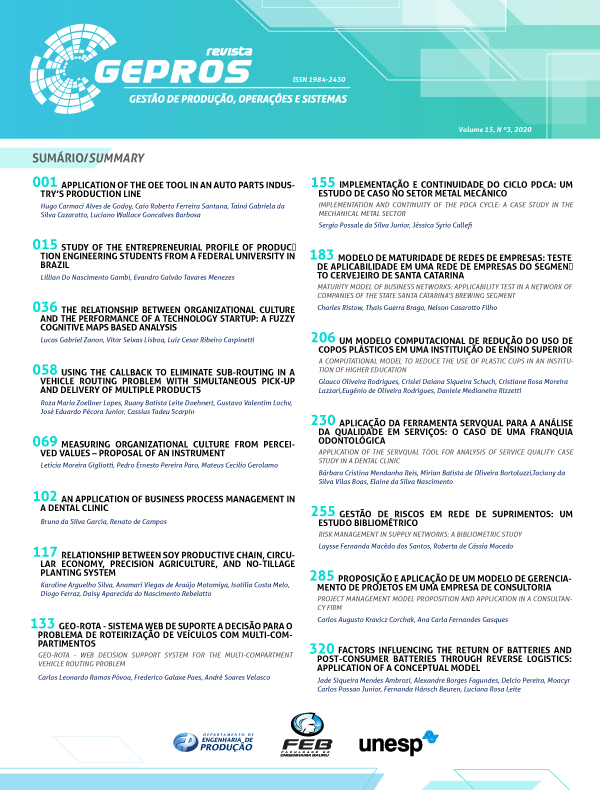Measuring Organizational Culture from perceived values – proposal of an instrument
DOI:
https://doi.org/10.15675/gepros.v15i3.2725Palavras-chave:
Cultural Values/Cross-Cultural Differences, Group or Organizational Culture/Climate, QualitativeResumo
The purpose of this paper is to present an instrument that aims to measure organizational culture from perceived values. This research was based on the robust method for culture diagnosis, the Competing Values Framework (CVF). Both theoretical and empirical studies were developed to understand the connection between the values perceived in an organizational context and the type of culture it presents. The development of the instrument followed the main four steps: (1) collection of values from literature; (2) classification of the values regarding the types of culture of the CVF they fit through panel with experts; (3) two applications of this instrument were carried out as well as the application of the Organizational Culture Assessment Instrument (OCAI) – also based on CVF; and (4) proposition of the final (current) version of the instrument. The proposed instrument is a qualitative method, and it is based on respondents’ insights to assess the actual values of the organization. Thus, the results can be considered an approximation of the actual characteristics presented in this environment. By applying this instrument, we expect that a diagnosis of organizational culture can be more straightforward and less error-prone, compared to other instruments that have the same purpose.Referências
Barrett, R. 2010. The Importance of Values in Building a High Performance Culture. Barrett Values Centre. Waynesville. Retrieved January 14, 2019 (https://www.valuescentre.com/sites/default/files/uploads/2010-07-06/The%20Importance%20of%20Values.pdf).
Brokaw, L. 2012. IKEA: Hiring on Values as Well as Skills. MIT Sloan Management Review. Retrieved January 14, 2019 (https://sloanreview.mit.edu/article/ikea-hiring-on-values-as-well-as, -skills/.).
Cameron, K. S., & Quinn, R. E. 2011. Diagnosing and Changing Organizational Culture: based on the Competing Values Framework. (3rd ed.). San Francisco: Jossey-Bass.
Campbell, D. 2011. What Great Companies Know About Culture. Harvard Business Review. Retrieved January 14, 2019 (https://hbr.org/2011/12/what-great-companies-know-abou.).
Cancialosi, C. 2015. Two Ways To Ensure Your Corporate Culture and Values Align. Forbes. Retrieved January 14, 2019 (https://www.forbes.com/sites/chriscancialosi/2015/07/20/2-ways-to-ensure-your-corporate-culture-and-values-align/#45585b586e31.).
Carucci, R. 2017. How Corporate Values Get Hijacked and Misused. Retrieved January 14, 2019. (https://hbr.org/2017/05/how-corporate-values-get-hijacked-and-misused).
Dvorak, N., & Nelson, B. 2016. Few Employees Believe in Their Company’s Values. Gallup. Retrieved January 14, 2019 (https://news.gallup.com/businessjournal/195491/few-employees-believe-company-values.aspx.)
Gleeson, B. 2017. How Values-Based Leadership Transforms Organizational Cultures. Forbes. Retrieved January 14, 2019 (https://www.forbes.com/sites/brentgleeson/2017/03/10/how-values-based-leadership-transforms-organizational-cultures/#1b8dd9b31fbd)
Groysberg, B., Lee, J., Prince, J., & Cheng J.Y. 2018.The Leader’s Guide to Corporate Culture. Harvard Business Review, 96(1): 44-52.
Guiso, L., Sapienza, P., & Zingales, L. 2013. The Value of Corporate Culture. MIT Economics. DOI: https://doi.org/10.3386/w19557
Handy, C. 1996. Gods of Management: The Changing Work of Organizations. New York: Oxford University Press.
Jones, G. R. 2010. Criando e gerenciando cultura organizacional. In Teoria das Organizações: 140-170. São Paulo: Pearson Education.
Katzenbach, J., Oelschlegel, C., & Thomas, J. 2016.10 Principles of Organizational Culture. Strategy+Business, Spring2016(2). Retrieved January 14, 2019 (https://www.strategy-business.com/feature/10-Principles-of-Organizational-Culture).
Lencioni, P. M. 2002. Make Your Values Mean Something. Harvard Business Review, 80(7): 113-117.
Quinn, R.E, & Rohrbaugh, J. 1983. A spatial model of effectiveness criteria: towards a competing values approach to organizational analysis. Management Science, 29(3): 363-377. DOI: https://doi.org/10.1287/mnsc.29.3.363
Quinn, R.E, & Rohrbaugh, J. 1981. A Competing Values Approach to Organizational Effectiveness. Public Productivity Review, 50(2): 112-140. DOI: https://doi.org/10.2307/3380029
Schein, E. H. 2009. The corporate culture survival guide (New and rev. ed.). San Francisco: Jossey-Bass.
Schein, E. H. 1984. Coming to a New Awareness of Organizational Culture. MIT Sloan Management Review, 25(2): 3-16.
Sethia, N., Von Glinow, M. 1985. Arriving at Four Cultures by Managing the Reward System. In Kilmann, R.H, M. J., & Serpa, R. (Eds.). Gaining Control of the Corporate Culture. San Francisco: Jossey-Bass.
Downloads
Arquivos adicionais
Publicado
Como Citar
Edição
Seção
Licença
O(s) autor(es) do artigo autorizam a publicação do texto na revista e garantem que a contribuição é original e inédita, não estando em processo de avaliação em outra(s) revista(s). As opiniões, ideias e conceitos emitidos nos textos são de inteira responsabilidade do(s) autor(es), não sendo a revista responsável por tais conteúdos.
Os editores da revista reservam o direito de efetuar ajustes textuais e de adequação às normas da publicação, caso necessário.
Os autores mantêm os direitos autorais sobre o trabalho e concedem à revista o direito de primeira publicação, sendo o trabalho simultaneamente licenciado sob a Attribution 4.0 International (CC BY 4.0), o que permite o compartilhamento do trabalho com reconhecimento da autoria e publicação inicial nesta revista.
Os autores têm autorização para firmar contratos adicionais, separadamente, para distribuição não-exclusiva da versão do trabalho publicada nesta revista (ex.: publicar em repositório institucional ou como capítulo de livro), com reconhecimento de autoria e publicação inicial nesta revista.












